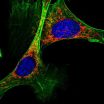(Press-News.org) To guarantee efficient use of nutrients, cells have systems that permit them to capture and transport the available nutrient molecules to their interior. But if several nutrients are available, cells can select those that are of most interest and discard undesired molecules.
Inside cells, nutrients are conducted to the mitochondria, the specialized cell organelles in which nutrients are combusted to release the energy held in their chemical bonds. Both sugars (glucose) and fats (fatty acids) are 'burned' in mitochondria, but these organelles need to adjust their molecular apparatus in different ways depending on whether their main fuel supply comes from sugars or fats. According to Dr. Enríquez, "This adjustment can be likened to refitting your boiler to burn natural gas or butane."
The proportion of different food fuels available to cells can be affected by diet, exercise, or a period of fasting, and cells need to be able to adapt to these changes. In some specific situations, for example during the activation of immune cells to defend the body against infection, cells change their activity even if the fuel source is unaltered, and this can be accompanied by changes in the preferential use of glucose instead of fatty acids or vice versa.
In all these cases, mitochondria need to adapt their 'fuel burners', technically known as the electron transport chain (ETC). "The ETC was known to adapt, but the signals that promote this change and the molecules responsible for it were not known."
The Cell Metabolism article describes the signals and molecules that regulate this adaptation. Combustion of nutrient fuels in mitochondria requires oxygen, and the process produces, in addition to energy, water (H2O) and carbon dioxide (CO2). But when the ETC switches from burning sugars to fatty acids, it is at first not adjusted to burning the new fuel, and additional oxygen derivatives are produced called reactive oxygen species (ROS), among them hydrogen peroxide (H2O2).
Production of H2O2 activates a molecular sensor called Fgr (Fgr-tyrosine kinase), which raises the alarm that the ETC is not adjusted to burn the fatty acids arriving in the mitochondria. It does this by modifying one of the components of the ETC, adding a phosphate group that makes it more active. This triggers a change in the organization of the ETC so that burns fatty acids more efficiently. The modification, called phosphorylation, is reversible, and the CNIC team believes that another, as-yet-unidentified molecule must trigger the reverse modification (dephosphorylation) when the mitochondrion's fuel burners need to switch back to burning glucose.
The study published in Cell Metabolism demonstrates the importance of this mechanism in the adaptation of cells to fasting and a limited oxygen supply (ischemia), and in the activation of cells of the immune system.
INFORMATION: END
Deciphered the process through which cells optimize metabolism to burn sugars or fats
Mitochondria adjust their 'fuel burners' to burn the right nutrient molecules, and the study describes the signals that promote this change
2014-05-22
ELSE PRESS RELEASES FROM THIS DATE:
New insight into stem cell development
2014-05-22
The world has great expectations that stem cell research one day will revolutionize medicine. But in order to exploit the potential of stem cells, we need to understand how their development is regulated. Now researchers from University of Southern Denmark offer new insight.
Stem cells are cells that are able to develop into different specialized cell types with specific functions in the body. In adult humans these cells play an important role in tissue regeneration. The potential to act as repair cells can be exploited for disease control of e.g. Parkinson's or diabetes, ...
Study: Some pancreatic cancer treatments may be going after the wrong targets
2014-05-22
ANN ARBOR, Mich. — New research represents a significant change in the understanding of how pancreatic cancer grows – and how it might be defeated.
Unlike other types of cancer, pancreatic cancer produces a lot of scar tissue and inflammation. For years, researchers believed that this scar tissue, called desmoplasia, helped the tumor grow, and they've designed treatments to attack this.
But new research led by Andrew D. Rhim, M.D., from the University of Michigan Comprehensive Cancer Center, finds that when you eliminate desmoplasia, tumors grow even more quickly and ...
'I can' mentality goes long way after childbirth
2014-05-22
The way a woman feels about tackling everyday physical activities, including exercise, may be a predictor of how much weight she'll retain years after childbirth says a Michigan State University professor.
James Pivarnik, a professor of kinesiology and epidemiology at MSU, co-led a study that followed 56 women during pregnancy and measured their physical activity levels, along with barriers to exercise and the ability to overcome them.
Six years later, the research team followed up with more than half of the participants and found that the women who considered themselves ...
What is being said in the media and academic literature about neurostimulation?
2014-05-22
Over the past several decades, neurostimulation techniques such as transcranial direct current stimulation (tDCS) have gradually gained favour in the public eye. In a new report, published yesterday in the prestigious scientific journal Neuron, IRCM ethics experts raise important questions about the rising tide of tDCS coverage in the media, while regulatory action is lacking and ethical issues need to be addressed.
TDCS is a non-invasive form of neurostimulation, in which constant, low current is delivered directly to areas of the brain using small electrodes. Originally ...
EuroPCR 2014 examines whether science translates into practice with new session format
2014-05-22
22 May 2014, Paris, France: The value of analysing published clinical trials and the benefit of informed discussion were highlighted yesterday when the ACCOAST trial data were discussed in a new session format—Will this trial change my practice?— at EuroPCR 2014. ACCOAST trial results demonstrate that pre-treatment with prasugrel in NSTEMI patients undergoing percutaneous coronary intervention (PCI) is inferior to treatment with the drug after angiography. Several other trials are also being scrutinised in the same format, which ends with a discussion with the audience ...
New details on microtubules and how the anti-cancer drug Taxol works
2014-05-22
A pathway to the design of even more effective versions of the powerful anti-cancer drug Taxol has been opened with the most detailed look ever at the assembly and disassembly of microtubules, tiny fibers of tubulin protein that form the cytoskeletons of living cells and play a crucial role in mitosis. Through a combination of high-resolution cryo-electron microscopy (cryo-EM) and new methodology for image analysis and structure interpretation, researchers with the Lawrence Berkeley National Laboratory (Berkeley Lab) and the University of California (UC) Berkeley have produced ...
Which way is up?
2014-05-22
What do sled dogs and cell clusters have in common? According to research by UC Santa Barbara's Denise Montell, they both travel in groups and need a leader to make sure they all follow in the same direction.
Montell, Duggan Professor of Molecular Cellular and Developmental Biology, and colleagues worked on three independent projects involving E-cadherin, a protein found in epithelial cells throughout the body. The researchers used fruit-fly ovaries to uncover the role played by E-cadherin in collective cell migration. Their findings are reported today in the journal ...
Eumelanin's secrets
2014-05-22
CAMBRIDGE, Mass-- Melanin — and specifically, the form called eumelanin — is the primary pigment that gives humans the coloring of their skin, hair, and eyes. It protects the body from the hazards of ultraviolet and other radiation that can damage cells and lead to skin cancer, but the exact reason why the compound is so effective at blocking such a broad spectrum of sunlight has remained something of a mystery.
Now researchers at MIT and other institutions have solved that mystery, potentially opening the way for the development of synthetic materials that could have ...
US obesity epidemic making all segments of the nation fatter, study finds
2014-05-22
The nation's obesity epidemic is striking all groups of Americans, affecting those with more education and those with less education, as well as all ethnic groups, according to a new analysis that challenges prevailing assumptions about the reasons why the nation is getting heavier.
While some differences in weight are evident between groups based on race and education levels, all Americans have been getting fatter at about the same rate for the past 25 years, even as the nation saw increases in leisure time, increased availability of fruit and vegetables, and increases ...
Being Sardinian puts a smile on the face of the elderly
2014-05-22
Residents of the Italian island of Sardinia are known for their longevity. Now, a new study also shows that elderly Sardinians are less depressed and generally are in a better mental frame of mind than peers living elsewhere. The study, led by Maria Chiara Fastame and Maria Pietronilla Penna of the University of Cagliari in Italy and Paul Hitchcott from the Southampton Solent University in UK, is published in Springer's journal Applied Research in Quality of Life.
Various tests to measure the mental state and capacity of elderly people were performed on 191 cognitively ...
LAST 30 PRESS RELEASES:
Coffee as a staining agent substitute in electron microscopy
Revealing the diversity of olfactory receptors in hagfish and its implications for early vertebrate evolution
Development of an ultrasonic sensor capable of cuffless, non-invasive blood pressure measurement
Longer treatment with medications for opioid use disorder is associated with greater probability of survival
Strategy over morality can help conservation campaigns reduce ivory demand, research shows
Rising temperatures reshape microbial carbon cycling during animal carcass decomposition in water
Achieving ultra-low-power explosive jumps via locust bio-hybrid muscle actuators
Plant-derived phenolic acids revive the power of tetracycline against drug-resistant bacteria
Cooperation: A costly affair in bacterial social behaviour?
Viruses in wastewater: Silent drivers of pollution removal and antibiotic resistance
Sub-iethal water disinfection may accelerate the spread of antibiotic resistance
Three in four new Australian moms struggle with body image
Post-stroke injection protects the brain in preclinical study
Cardiovascular risk score predicts multiple eye diseases
Health: estimated one in ten British adults used or interested in GLP-1 medications for weight loss
Exercise to treat depression yields similar results to therapy
Whooping cough vaccination for pregnant women strengthens babies’ immune system
Dramatic decline in new cases of orphanhood in Uganda driven by HIV treatment and prevention programs
Stopping weight loss drugs linked to weight regain and reversal of heart health markers
Higher intake of food preservatives linked to increased cancer risk
Mass General Brigham–developed cholera vaccine completes phase 1 trial
First experimental validation of a “150-year-old chemical common sense” direct visualization of the molecular structural changes in the ultrafast anthracene [4+4] photocycloaddition reaction
Lack of support for people on weight loss drugs leaves them vulnerable to nutritional deficiencies, say experts
Dogs’ dinners can have greater climate impact than owners’
Are you ready to swap salmon for sprats and sardines?
1.6 million UK adults used weight loss drugs in past year
American College of Cardiology comments on new dietary guidelines for Americans
American Society of Gene & Cell Therapy and Orphan Therapeutics Accelerator partner to advance and commercialize promising rare disease treatments
One in 14 patients having day case surgery have new or worse chronic pain 3 months after their operation
New study highlights link between eviction rates and gun violence
[Press-News.org] Deciphered the process through which cells optimize metabolism to burn sugars or fatsMitochondria adjust their 'fuel burners' to burn the right nutrient molecules, and the study describes the signals that promote this change



